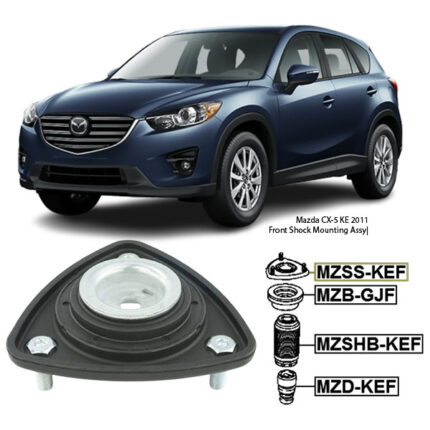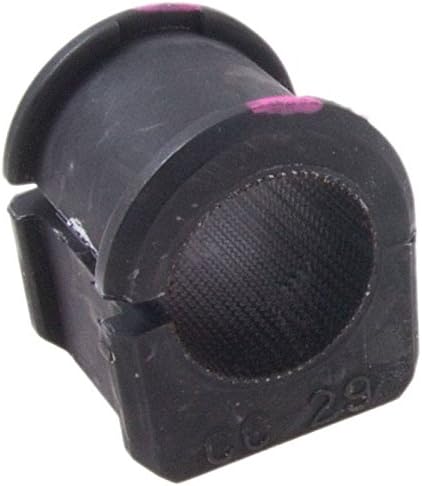-25%
Get Mazda Axela Biante Front Stabilizer Bushing
The front stabilizer bushing, also known as the sway bar bushing, is a crucial component in the suspension system of a vehicle. It connects the stabilizer bar (or sway bar) to the frame or control arms of the vehicle. This bushing allows for controlled movement of the stabilizer bar while minimizing noise and vibration. Here’s an in-depth look at the front stabilizer bushing, its functions, signs of wear or failure, and maintenance considerations:
Functions of Front Stabilizer Bushing
-
1. Reduction of Body Roll
Primary Function: Minimize the leaning or tilting of the vehicle’s body during turns.
- Mechanism: The stabilizer bar (or sway bar) is connected to the vehicle’s suspension components and runs across the front of the vehicle. When the vehicle turns, the bar twists, resisting the body’s tendency to roll. The bushings, positioned at the mounting points of the stabilizer bar, allow the bar to pivot and twist effectively.
- Impact: By minimizing body roll, the stabilizer bushings help maintain better tire contact with the road, leading to improved traction and stability during turns. This function is crucial for maintaining vehicle control, especially during high-speed maneuvers or abrupt directional changes.
2. Dampening of Vibrations and Noise
Primary Function: Absorb and reduce vibrations and noise from the road.
- Mechanism: The bushings are made of rubber or polyurethane, materials known for their damping properties. They isolate the metal components of the stabilizer bar from the frame of the vehicle, which helps absorb road vibrations and reduces the transmission of noise into the vehicle cabin.
- Impact: This damping effect contributes to a smoother and quieter ride, enhancing passenger comfort. It also protects other suspension components from excessive wear caused by constant vibration.
3. Allowing Controlled Movement
Primary Function: Facilitate the controlled movement and pivoting of the stabilizer bar.
- Mechanism: The bushings provide a pivot point for the stabilizer bar, allowing it to twist as the suspension moves up and down. This controlled movement is essential for the stabilizer bar to perform its function of reducing body roll.
- Impact: By allowing the stabilizer bar to move freely within a controlled range, the bushings ensure that the suspension system responds correctly to road conditions and driving maneuvers, maintaining vehicle stability and handling.
4. Maintaining Suspension Geometry
Primary Function: Ensure the proper alignment and geometry of the suspension system.
- Mechanism: The bushings keep the stabilizer bar securely mounted to the vehicle’s frame or control arms. This secure mounting is essential for maintaining the correct geometry of the suspension system, ensuring that all components work together as designed.
- Impact: Proper suspension geometry is vital for optimal handling, tire wear, and overall vehicle performance. The bushings play a critical role in maintaining this geometry by preventing unwanted movement of the stabilizer bar.
5. Enhancing Tire Contact and Traction
Primary Function: Improve tire contact with the road surface.
- Mechanism: By reducing body roll and maintaining suspension alignment, the stabilizer bushings help ensure that the tires remain in optimal contact with the road. This is particularly important during cornering, braking, and acceleration.
- Impact: Enhanced tire contact leads to better traction and grip, which improves overall vehicle safety and performance. This is crucial for both everyday driving and more demanding driving conditions.
6. Protecting Suspension Components
Primary Function: Prevent excessive wear on other suspension components.
- Mechanism: The damping and cushioning effect of the bushings reduce the stress and impact on other suspension parts, such as the stabilizer links, control arms, and shocks or struts.
- Impact: By reducing stress and preventing excessive movement, the bushings help extend the lifespan of other suspension components, leading to lower maintenance costs and more reliable vehicle performance over time.
Signs of Worn or Failing Front Stabilizer Bushings
- Clunking or Rattling Noises
- Description: Noises coming from the front suspension, particularly when driving over bumps or rough roads.
- Details: Worn or damaged bushings can cause the stabilizer bar to move excessively, creating clunking or rattling sounds as it impacts other suspension components or the vehicle’s frame.
- Excessive Body Roll
- Description: Increased leaning or swaying of the vehicle during turns.
- Details: If the bushings are worn out, the stabilizer bar cannot effectively counteract body roll, leading to a noticeable increase in body lean during cornering.
- Poor Handling and Stability
- Description: Reduced handling performance and stability.
- Details: Worn bushings can compromise the stabilizer bar’s ability to maintain proper suspension alignment, affecting the vehicle’s handling and stability, especially during high-speed maneuvers.
- Uneven Tire Wear
- Description: Abnormal wear patterns on the front tires.
- Details: Failing bushings can affect suspension alignment, leading to uneven tire contact with the road and resulting in premature tire wear.
- Steering Issues
- Description: Loose or less responsive steering.
- Details: Worn stabilizer bushings can cause a looseness in the suspension system, leading to vague or imprecise steering response.
- Visual Inspection
- Description: Cracks, tears, or deformation in the bushings.
- Details: During routine inspections, visible signs of wear or damage to the bushings indicate they need replacement.
Maintenance and Replacement
- Regular Inspection
- Check for Wear: Include front stabilizer bushings in routine maintenance checks, looking for signs of wear, damage, or deterioration.
- Detailed Examination: Inspect the bushings during vehicle servicing or when addressing any suspension-related issues.
- Prompt Replacement
- Replace When Worn: Replace any worn or damaged stabilizer bushings promptly to prevent further damage to the suspension system.
- Quality Parts: Use high-quality OEM or reputable aftermarket bushings to ensure durability and proper fitment.
- Professional Installation
- Expert Service: Consider having a qualified mechanic perform the replacement, as it may require specialized tools and expertise to remove and install the bushings correctly.
- Alignment Check: After replacing the stabilizer bushings, have a professional wheel alignment performed to ensure proper suspension geometry and handling.
Follow us on Facebook for more parts.



